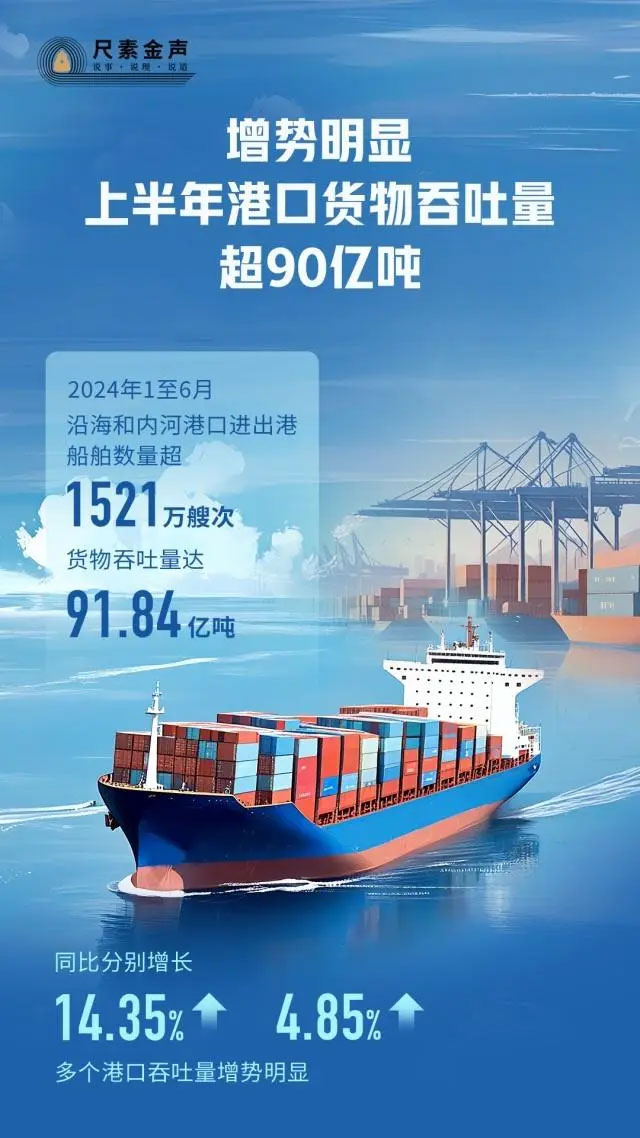

The growth trend is obvious, the port cargo throughput in the first half of the year exceeded 9 billion tons
Ports, important gateways for goods import and export; Port cargo throughput, the "barometer" of national economic development. Recently, China's port operation "semi-annual report" announced: From January to June this year, the number of coastal and inland port inbound and outbound vessels exceeded 15.21 million times, and the cargo throughput reached 9.184 million tons, an increase of 14.35% and 4.85% respectively, and the throughput of many ports increased significantly.
Shanghai Port, the world's largest container port, LNG dual-fuel new car ro-RO ship "Minjiangkou" made its first voyage to dock at Waigaoqiao Haitong Dock, more than 4,800 domestic brand cars entered the ro-ro in an orderly way, starting the voyage to the Persian Gulf. Two days later, the same batch of delivery "Liaohekou" ship will also dock here, loading 4,100 commercial vehicles bound for Europe.
New ships with new cars continue to export heat. In the first half of the year, more than 610,000 domestic vehicles were exported from the Haitong terminal, an increase of more than 27% year-on-year. This means that every day, more than 3,000 cars go to sea, to hundreds of countries and regions around the world.
Ningbo Zhoushan Port, the world's first annual cargo throughput port. A batch of photovoltaic modules from Jinke Energy Jianshan factory in Haining, Zhejiang, arrived at Meishan Port area, were quickly shipped and then sent to Saudi Arabia. In the first half of the year, JinkoEnergy Haining Company exported about 23,000 containers of products through Ningbo Zhoushan Port to the Middle East, Europe, Asia Pacific and other regions, an increase of more than 50%.
Open up new routes and expand new markets. In the first half of the year, Ningbo Zhoushan Port completed the cargo throughput of 708 million tons, an increase of 4.2%, supporting Ningbo's import and export value in the first half of the year exceeded 680 billion yuan, another record high.
With the Port of Shanghai and the Port of Zhoushan in Ningbo as the core, and 16 ports such as Nanjing, Hangzhou and Suzhou as the backbone, China's coastal port cluster with the densest and largest throughput has become an important platform for smooth domestic and international double circulation. In the first half of the year, the port cargo throughput exceeded 9 billion tons, which strongly confirmed the continuous recovery of the Chinese economy. In the first half of the year, the total value of China's goods trade import and export was 21.17 trillion yuan, an increase of 6.1%, and exceeded 21 trillion yuan for the first time in history.
Ports serve commerce and carry economic development.
In recent years, the port city has been deeply engaged in the high-quality development of the port and endeavoured to develop and expand the port economy. Taking Tianjin Port as an example, by focusing on the port's advantageous goods and Tianjin's advantageous industries, while consolidating and expanding the scale of petrochemical, grain and oil processing industries, it continues to attract a number of characteristic industries such as cold chain logistics, cross-border e-commerce, and cruise economy to take root in Tianjin. The port economic added value of 59 seaport cities in China reached 6.2 trillion yuan last year, accounting for 13.4 percent of the total economic output of these cities, according to the latest report from the Ministry of Transport. Among them, the port economy accounted for 15%, 22% and 8% in the primary, secondary and tertiary industries of the port city, respectively, showing that the port's supporting role in the primary and secondary industries is increasingly significant.
The port has witnessed the increase of economic heat and has also accumulated new strength for development.
The hardware is being upgraded. In the first half of the year, China's ports added seven large-scale automated terminals, and the number of automated terminals built or under construction continued to rank first in the world. Intelligent transportation equipment such as a new generation of automatic guided vehicles and unmanned collection cards based on 5G technology have been put into use successively, effectively improving the efficiency of port operations and helping the continuous and rapid growth of cargo throughput.
The course is thickening. Nearly 90% of the goods in global trade are completed by sea, and the number of routes is directly related to trade accessibility. To the east, Ningbo Zhoushan Port opened three new international routes in the first half of the year, maintaining a high of 300 routes in Hong Kong, for more enterprises to expand space; Extending to the west, Tianjin Port has opened sea-rail intermodal trains to Hohhot and Chifeng this year, effectively connecting the inland hinterland and activating the regional development potential.
Service is optimized. Ningbo Zhoushan Port innovates to realize "one declaration, one inspection and one release" for the export containers of the sea-rail combined freight train, which helps Yiwu's small commodities reach the world quickly; Guangzhou takes Nansha Port as the hub port and Pearl River inland port as the feeder port, forming a "two ports as one port" operation mode... The "soft connectivity" of port construction changes the flow of goods into the development increment.
Hong Kong connects the four seas, and the land connects the eight. The shuttling of giant ships and the busy operation of tower cranes weave a vivid picture of development.

Shanghai Port, the world's largest container port, LNG dual-fuel new car ro-RO ship "Minjiangkou" made its first voyage to dock at Waigaoqiao Haitong Dock, more than 4,800 domestic brand cars entered the ro-ro in an orderly way, starting the voyage to the Persian Gulf. Two days later, the same batch of delivery "Liaohekou" ship will also dock here, loading 4,100 commercial vehicles bound for Europe.
New ships with new cars continue to export heat. In the first half of the year, more than 610,000 domestic vehicles were exported from the Haitong terminal, an increase of more than 27% year-on-year. This means that every day, more than 3,000 cars go to sea, to hundreds of countries and regions around the world.
Ningbo Zhoushan Port, the world's first annual cargo throughput port. A batch of photovoltaic modules from Jinke Energy Jianshan factory in Haining, Zhejiang, arrived at Meishan Port area, were quickly shipped and then sent to Saudi Arabia. In the first half of the year, JinkoEnergy Haining Company exported about 23,000 containers of products through Ningbo Zhoushan Port to the Middle East, Europe, Asia Pacific and other regions, an increase of more than 50%.
Open up new routes and expand new markets. In the first half of the year, Ningbo Zhoushan Port completed the cargo throughput of 708 million tons, an increase of 4.2%, supporting Ningbo's import and export value in the first half of the year exceeded 680 billion yuan, another record high.
With the Port of Shanghai and the Port of Zhoushan in Ningbo as the core, and 16 ports such as Nanjing, Hangzhou and Suzhou as the backbone, China's coastal port cluster with the densest and largest throughput has become an important platform for smooth domestic and international double circulation. In the first half of the year, the port cargo throughput exceeded 9 billion tons, which strongly confirmed the continuous recovery of the Chinese economy. In the first half of the year, the total value of China's goods trade import and export was 21.17 trillion yuan, an increase of 6.1%, and exceeded 21 trillion yuan for the first time in history.
Ports serve commerce and carry economic development.
In recent years, the port city has been deeply engaged in the high-quality development of the port and endeavoured to develop and expand the port economy. Taking Tianjin Port as an example, by focusing on the port's advantageous goods and Tianjin's advantageous industries, while consolidating and expanding the scale of petrochemical, grain and oil processing industries, it continues to attract a number of characteristic industries such as cold chain logistics, cross-border e-commerce, and cruise economy to take root in Tianjin. The port economic added value of 59 seaport cities in China reached 6.2 trillion yuan last year, accounting for 13.4 percent of the total economic output of these cities, according to the latest report from the Ministry of Transport. Among them, the port economy accounted for 15%, 22% and 8% in the primary, secondary and tertiary industries of the port city, respectively, showing that the port's supporting role in the primary and secondary industries is increasingly significant.
The port has witnessed the increase of economic heat and has also accumulated new strength for development.
The hardware is being upgraded. In the first half of the year, China's ports added seven large-scale automated terminals, and the number of automated terminals built or under construction continued to rank first in the world. Intelligent transportation equipment such as a new generation of automatic guided vehicles and unmanned collection cards based on 5G technology have been put into use successively, effectively improving the efficiency of port operations and helping the continuous and rapid growth of cargo throughput.
The course is thickening. Nearly 90% of the goods in global trade are completed by sea, and the number of routes is directly related to trade accessibility. To the east, Ningbo Zhoushan Port opened three new international routes in the first half of the year, maintaining a high of 300 routes in Hong Kong, for more enterprises to expand space; Extending to the west, Tianjin Port has opened sea-rail intermodal trains to Hohhot and Chifeng this year, effectively connecting the inland hinterland and activating the regional development potential.
Service is optimized. Ningbo Zhoushan Port innovates to realize "one declaration, one inspection and one release" for the export containers of the sea-rail combined freight train, which helps Yiwu's small commodities reach the world quickly; Guangzhou takes Nansha Port as the hub port and Pearl River inland port as the feeder port, forming a "two ports as one port" operation mode... The "soft connectivity" of port construction changes the flow of goods into the development increment.
Hong Kong connects the four seas, and the land connects the eight. The shuttling of giant ships and the busy operation of tower cranes weave a vivid picture of development.





